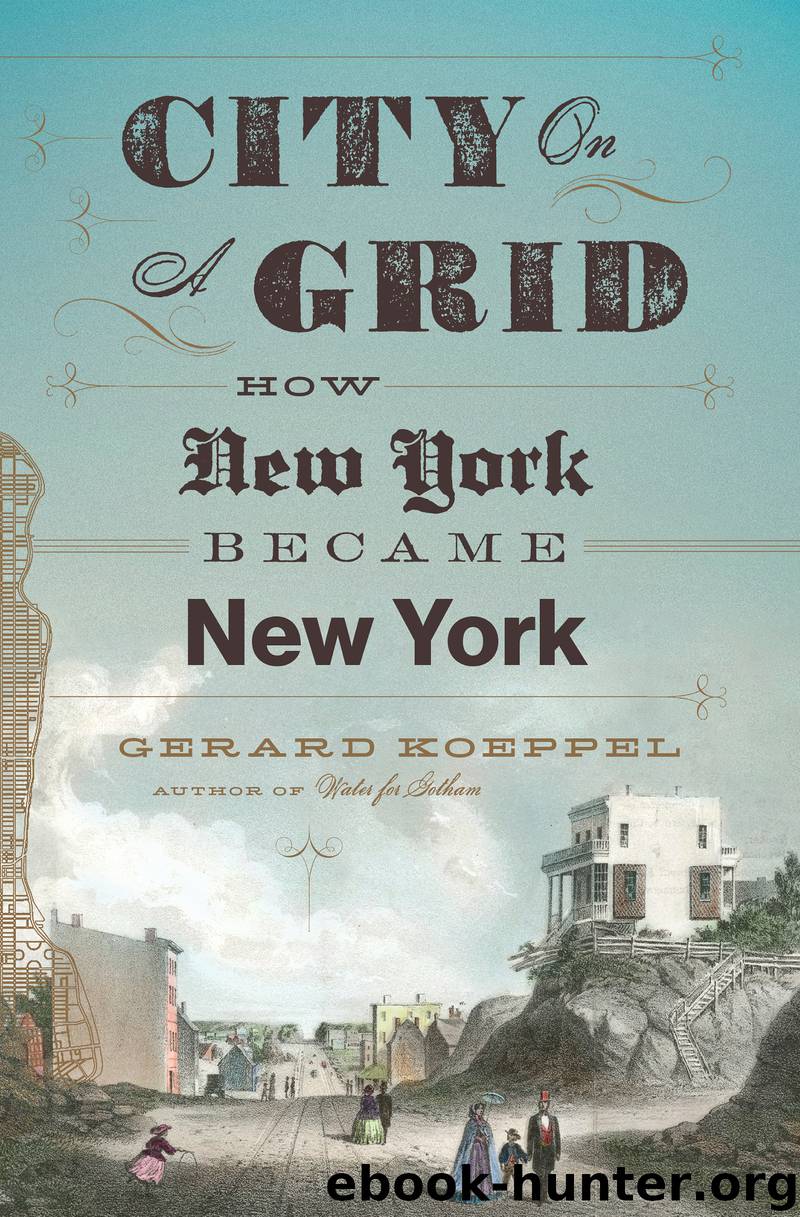City on a Grid by Gerard Koeppel

Author:Gerard Koeppel
Language: ara, eng
Format: epub
Publisher: Da Capo Press
Published: 2015-09-02T15:19:14+00:00
Our perpetual dead flat, and streets cutting each other at right angles, are certainly the last things in the world consistent with beauty.
—Walt Whitman, Sunday Dispatch, 1849
The time will come when New York will be built-up, when all the grading and filling will be done, when the picturesquely varied rock formations of the island will have been converted into the foundations for rows of monotonous straight streets, and piles of erect, angular buildings.
—Frederick Law Olmsted, 1858
In crowded William Street on Saturday, May 12, 1849, a seeming acquaintance approached Thomas MacDonald. After a few moments’ conversation, as MacDonald was trying to recall the apparent fellow gentleman’s name, he asked, “Have you confidence in me to trust me with your watch until to-morrow?” The request seemed reasonable enough to McDonald, distracted by embarrassment, as he handed over his gold lever pocket watch, a very considerable $110 value. The next day, the man did not return the watch as promised to MacDonald’s home. Nor did McDonald see him again until July 7, when, two months wiser, he caught sight of the man on Liberty Street and hailed a police officer, who hauled off the man, after a bit of a struggle, to jail at the city’s infamous Tombs. There a judge recognized him as habitual offender William Thompson, “a graduate of the college at Sing Sing,” the state prison up the Hudson. Unsuccessful in his prior schemes, in the spring of 1849 Thompson had devised a new criminal personality: the “confidence man,” as the penny press giddily dubbed him. Though he met with no greater success as a confidence man than in previous illicit pursuits, Thompson was the avatar of a new criminal class in New York; by the 1860s, an estimated one in ten of the city’s professional criminals were confidence men, preying on the watches, jewelry, cash, and credulity of their fellow New Yorkers. There has been no shortage of con men since.
Thompson and his disciples were enabled by a city that was becoming dense and anonymous, rich and poor, a breeding ground for fowlers and marks. The scandal-mongering Herald, which gave Thompson’s swindler persona its enduring name, saw a city awash in all sorts of “confidence men.” Some were Thompsons who worked particular streets and wound up in small rooms with iron bars. Others, the “possessors of suddenly acquired wealth,” worked along the same streets but lived in massive new “evidences of a lavish and almost profligate expenditure.” These
palazzos, with all their costly furniture, and all their luxurious means of living, and all their splendid equipages, have been the product of the same genius in their proprietors, which has made the “Confidence Man” immortal and a prisoner at “the Tombs.” His genius has been employed on a small scale in Broadway. Theirs has been employed in Wall street. . . . Long life to the real “Confidence Man!”—the “Confidence Man” of Wall street—the “Confidence Man” of the palace up town—the “Confidence Man” who battens and fattens on the plunder coming
Download
This site does not store any files on its server. We only index and link to content provided by other sites. Please contact the content providers to delete copyright contents if any and email us, we'll remove relevant links or contents immediately.
| African Americans | Civil War |
| Colonial Period | Immigrants |
| Revolution & Founding | State & Local |
Cat's cradle by Kurt Vonnegut(15182)
Pimp by Iceberg Slim(14387)
4 3 2 1: A Novel by Paul Auster(12281)
Underground: A Human History of the Worlds Beneath Our Feet by Will Hunt(12022)
The Radium Girls by Kate Moore(11921)
Wiseguy by Nicholas Pileggi(5669)
Perfect Rhythm by Jae(5324)
American History Stories, Volume III (Yesterday's Classics) by Pratt Mara L(5255)
The Fire Next Time by James Baldwin(5248)
Paper Towns by Green John(5087)
Pale Blue Dot by Carl Sagan(4909)
A Higher Loyalty: Truth, Lies, and Leadership by James Comey(4842)
The Mayflower and the Pilgrims' New World by Nathaniel Philbrick(4421)
The Doomsday Machine by Daniel Ellsberg(4415)
Killers of the Flower Moon: The Osage Murders and the Birth of the FBI by David Grann(4385)
The Sympathizer by Viet Thanh Nguyen(4305)
Too Much and Not the Mood by Durga Chew-Bose(4270)
The Borden Murders by Sarah Miller(4243)
Sticky Fingers by Joe Hagan(4100)
